Top News
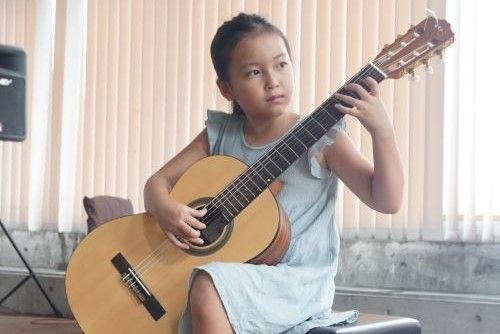
June 16, 2021 Ryukyu Shimpo
By Saki Yoshida
On June 13, Hana Hanzawa, 7, a second grader at Jonan Elementary School in Naha City, won first place in the lower elementary school division of the national 43rd Junior Guitar Competition (sponsored by Japan Junior Guitar Education Association). Hana said with a big smile, “I jumped for joy when I found out I won.” She began playing the guitar when she was three years old and diligently practices with her father every day, Noel Billingsley, 41, a classical guitarist.
Due to the pandemic, the competition was judged based on video clips of performances. Hana chose two contrasting songs for her freestyle performance—a slow and sad piece, and a fast and cheerful piece. She tirelessly practiced the songs along with basic exercises. Noel said of his daughter, “She’s a very fast learner. I’m excited to see if she will be able to play songs that are challenging for adults.”
Two years ago, Hana participated in the infant division of the same competition for the first time and won second place. Since then, the young guitarist, who has a competitive side, devoted herself to practicing and came out on top this time.
Hana found her love for the guitar after she received one as a gift for her third birthday. She now plays every day. Hana said with a smile, “I want to practice harder so I can play a variety of songs.”
(English translation by T&CT and Monica Shingaki)
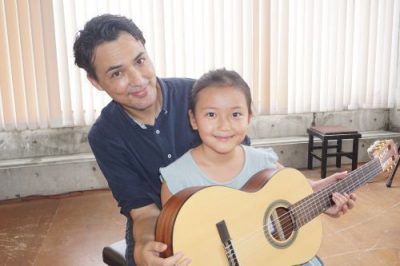
Hana Hanzawa with her father, Noel Billingsley (left), a classical guitarist.
Go to Japanese

June 18, 2021 Ryukyu Shimpo
By Ryota Shimabukuro
Okinawa City has incorporated “working on research studies and activities appealing to the national government” regarding the joint military/civilian use of Kadena Air Base into the early stages basic plan of the city’s fifth comprehensive plan that sets forth policy guidelines for FY2021 through FY2025. According to Okinawa City, this is the first time that the city has systematically researched the joint military/civilian use of Kadena Air Base. The city aims to compile the results of studies about the legal system, economic effects, and the impact on noise during the plan period.
The plan cites “development of the central region and revitalization of the city” as the reason that joint military/civilian use is a goal. Meanwhile, Kadena Air Base already has a noise problem, and city officials maintain that the studies will also verify the disadvantages of joint military/civilian use.
The plan states that “the functionality of the airport and port as hubs for tourism and distribution is essential” and that the city will “conduct research studies on the utilization of Kadena Air Base, which has two runways, and make requests to the national government.” The city has built upon the goals of the 4th comprehensive plan for “promoting the return of U.S. military bases, etc., and advancing efforts toward joint use of base facilities.”
Establishing joint military/civilian use of Kadena Air Base was a campaign promise by Mayor Sachio Kuwae. Mayor Kuwae explained in an interview with the Ryukyu Shimpo that “Kadena Air Base is a great burden, but if it can be effectively used as a resource, I would like to use it for economic development in the central part [of the island].” He also expressed his desire to visit bases such as the U.S. military’s Misawa Air Base in Aomori prefecture, which is already a military/civilian joint-use facility. He said, “It can be nerve-wracking because the area surrounding Kadena Air Base is troubled by noise, but the noise of civilian aircraft is different from that of fighter aircraft. Due to the presence of Naha Airport, the number of flights seems unlikely to increase.”
Mayor Kuwae expressed his understanding that requests to the national government and the U.S. military will be premised on consensus among neighboring local governments, such as the Three Municipalities’ Liaison Council concerning Kadena Air Base (Trilateral Liaison Council) made up of Okinawa City, Kadena Town, and Chatan Town. Mayor Kuwae said, “We haven’t reached a consensus with the Trilateral Liaison Council yet, and we must pursue it as a process. A proposal will come with careful attention to our timing.” He acknowledged that “the hurdles are high”, such as receiving assent from the U.S. military.
(English translation by T&CT and Erin Jones)
Go to Japanese
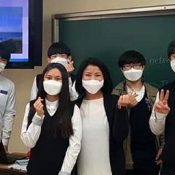
By Minami Asato Tamamoto
At Pyeongtaek Mechanical and Technical High School, located in Pyeongtaek, around a 90-minute drive from Seoul, Korea, Uruma-native Mariko Yokota, 33, teaches students about Okinawan history and culture in her foreign cultures class. Yokota had been a teacher for a number of years. She worked at Kadena Air Base previously, but has been in Korea since 2017 when her husband, who is in the U.S. military, was transferred there. She is also the mother of two children.
The school she teaches at in Korea has many students who go right into working at companies like Samsung instead of continuing on to university. Yokota has gathered a group of students who want to learn Japanese, and is in charge of a Japanese Cultural Experience Club, which comprises six 50-minutes lectures.
Each lecture has a theme such as “Korean lifestyle” and “Okinawa history and culture.” In the lecture held April 21, the class focused on the history of exchange and similarities between Okinawa and Korea.
Yokota explains, “Okinawa has the history and culture of champuru (a dish that is seen as a mixture of many cultures), and as a diverse, multicultural island, it can communicate to the world messages of peace and that ‘life is a treasure.’ She touched on the complicated issues that exist between Japan and Korea, telling her students, “I want us to work together to become peace makers.”
The students expressed their surprise with comments like, “I didn’t know about and island like Okinawa,” and “I didn’t think Korea and Okinawa would have so many similarities.” Yokota said of the issues between Japan and Korea, “Working to encourage everyday people to learn to understand one another like this creates ties from person to person. As someone born in the cultural mix and life-valuing Okinawa, my life work might be building bridges across different cultures, such as using Okinawa as a window to strengthening the bond with Korea. Harmonizing between societies and people with differing backgrounds leads to more peaceful world.”
(English translation by T&CT and Sam Grieb)
Go to Japanese

June 12, 2021 Ryukyu Shimpo
Packed with capsaicin and vitamin C, chili peppers are known to be effective in combating summer heat fatigue. Forty-eight-year-old Hitoshi Sunagawa’s greenhouse in Toyama Tamagusuku, Nanjo is colored with the reds and greens of chili peppers from around 600 plants as they enter their peak harvesting season. On June 11 he got to work picking peppers, including one that had grown to 10 centimeters.
The chili peppers Sunagawa raises grow to about twice the size of regular chili peppers. Called “Okinawa southern chilies,” the new Okinawan product has been gaining attention. “I want people who have suffered from a lack of exercise due to the coronavirus pandemic, and for people stuck at home to try food cooked with these chilies, and for it to give them some power,” he said, noting the chilies’ ability to make customers sweat as he happily picked peppers.
According to Sunagawa, harvesting on a rainy day leaves his hands tingling and warm. “When my fingertips heat up from the spiciness of the chilies, that’s when I know I’ve grown some good peppers.” It makes for some “hot” work in the summer greenhouse. Sunagawa is predicting a harvest this year of around two tons of peppers.
(English translation by T&CT and Sam Grieb)
Go to Japanese
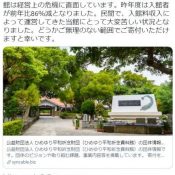
June 7, 2021 Ryukyu Shimpo
On the morning of June 6, the Himeyuri Peace Museum, which has seen a dramatic decrease in visitors as a result of Covid-19, posted about its dire “operational crisis” on Twitter. The tweet was retweeted widely, leading to a sudden inflow of donations. The museum received 4,990 donations, reaching a total of roughly 17.5 million yen, on its donation site between the time of the tweet and 5:30 p.m. on June 7. Compared to the figures from the time it opened its donation site in October of last year until April, the amount donated was 5.4 times and the number of donations reached 28.5 times those figures.
The museum had 491,345 visitors in the 2019 business year. As a result of Covid-19, cancellations of school trips and other factors caused visitors to fall to only 66,532 in the 2020 business year, an 86% reduction compared to 2019. In the 2021 business year, the difficult situation continued, with only 4,151 visitors in April and 4,908 in May.
The tweet was posted at 9:21 a.m. on June 6. It explained that visitors had decreased as a result of Covid-19 and made an urgent plea, stating, “This situation is extremely difficult for our museum, which is a private organization and relies on admission fees for its operation. We would greatly appreciate donations of any amount.”
The tweet spread on Twitter and other SNS. Many people announced that they had made donations, with comments such as “This museum needs to keep existing” and “I donated 100 thousand yen,” and the message continued to spread. As of 6:00 p.m. on June 7, the original tweet had received a total of more than 23,000 retweets and likes as the circle of support spread further.
According to the museum, it started using the donation site “Syncable” (https://syncable.biz/associate/himeyuri/) in October of last year as visitors decreased, and as of April, it had received 175 donations reaching a total of 3.22 million yen. After the tweet, it received 2,637 donations of a total of roughly 8.98 million yen by 5:30 p.m. on June 6, and 4,990 donations of a total of 17.5 million yen by 5:30 p.m. on June 7.
“It came as a surprise. We received donations from many people, and all of us at the museum are full of gratitude. Our operations are still strained, but we are greatly encouraged by all of the warm comments we received,” said Katsumi Maedomari, curator of the museum.
The Himeyuri Peace Museum is a privately operated museum founded by the Himeyuri Peace Foundation, a foundation having the Himeyuri alumni association, an association of former students of the pre-war Okinawa Shihan Women’s School and the Okinawa Daiichi Women’s High School, as its parent organization. It serves as a place for activities to link the tragedy of war and appreciation of peace to the future through the experiences of students and others who were mobilized during the Battle of Okinawa. Its operational expenses for the 2019 business year were 147.62 million yen. It receives no public funding and relies on admission fees and donations for its operations.
(English translation by T&CT and Sandi Aritza)
Go to Japanese
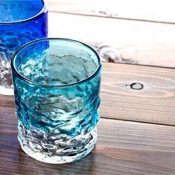
June 10, 2021 Ryukyu Shimpo
Okinawa’s awamori industry voiced its excitement as the Japanese government announced plans to list awamori as an Intangible Cultural Heritage with the United Nations Educational, Scientific and Cultural Organization (UNESCO).
Once registered as an Intangible Cultural Heritage, awamori can be expected to earn the status of a national spirit, along with sake and shochu. Manabu Sakumoto, president of the Prefectural Distillers Association, said, “It will give people the opportunity to discover that Japan has its own distilled spirit with a long history, like other world-famous spirits such as tequila, whiskey, and gin. We will work to promote awamori to as many people as we can, and find more opportunities.”
Since Okinawa’s reversion to Japan, local awamori sales have enjoyed a 35% liquor tax discount. Considering 80% of awamori is consumed within the prefecture, the tax break has been beneficial to the awamori industry. In recent years, however, some have challenged the necessity of the incentive. Sakumoto said, “If we can shift the sales percentage to other prefectures and countries, [the industry] can be self-sufficient.”
Yuiko Morita, Chair of the Awamori Meisters Association, said, “In addition to its complex flavor and cultural essence, awamori is an excellent spirit for its versatility. It embodies Okinawan culture and tradition and is worthy of being an intangible cultural heritage.” She further explained that awamori comes in a wide range of alcohol content, from 16 to 43 degrees, and can be enjoyed with a splash of water, on the rocks, or used in cocktails.
Morita pointed to tequila, a spirit born in a small town in Mexico, which gained worldwide popularity thanks to the margarita cocktail. “The possibilities for awamori are limitless. If we can elevate its recognition and set up a proper distribution network, I have no doubt it will be widely accepted.”
Yoshinori Kyan, chair of the Prefectural Wholesale Liquor Association, said, “It’s wonderful news. If the government is taking action, the registration process should fast track.” Kyan has high hopes that once awamori gains global recognition, the Japanese consumers will take a renewed interest in the spirit. “[In which case] many tourists will want to try awamori when they visit Okinawa. The demand for awamori as souvenirs will also increase,” he said.
(English translation by T&CT and Monica Shingaki)
Go to Japanese
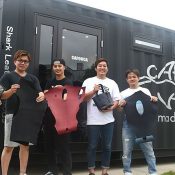
June 11, 2021 Ryukyu Shimpo
By Sanemichi Kinjo
Nanjo – In Taira Ozato, there is a leatherworker who turns the skins of culled sharks into products. Ryuma Kinjo (Naha) has already made 200 sharkskin products such as wallets and bags. He explains, “I want to give sharks that were killed for being a nuisance new life as appealing products.”
After graduating high school, Kinjo started working at a leather workshop in Okinawa. He practiced his craft there for seven years. When he was 21, a classmate who works in the tuna industry asked him, “can you make wallets out of shark?” At first, Kinjo refused, believing it was impossible. But he was shocked to learn that 200 sharks are culled and disposed of in Okinawa annually. Upon learning that leather products using shark skin are being made in Kesennuma, Miyagi, he decided “I want to use the culled sharks to make something.”
In 2019, Kinjo started his own brand, cafooca, and set out to make sharkskin products. He visited fishing ports throughout the Okinawa, skinning the tiger sharks that had been culled. He says, “At first, it took me two or three hours to skin one shark.” Then he would have the skins tanned by a tanner outside of Okinawa, turning the skins into leather. Kinjo recalls, “The first time I held tanned sharkskin, I was impressed by how rough and thick it is.”
Kinjo makes his leather products in silence at his workshop in Taira. Recently, he has received more orders from both inside and outside of Okinawa, and in March, his brand was authorized as a Nanjo Selection 2020. He was also chosen from among 405 nominees throughout Japan as a finalist for the TOYP 2021 (the young People’s Honor Award). Results will be announced in July. Kinjo says, “Sharkskin is highly water resistant and damage resistant. No two skins have the same pattern, so each item is the only one of its kind in the world.” He donates a portion of his sales to orphanages and to the reconstruction of Shuri Castle.
On June 27, he will open a container shop next to his workshop. He says, “I received 1,050,000 yen in support through crowdfunding, and used the money to open a shop with a friend I’ve known since junior high school. The interior of the shop has a great atmosphere, it’s wonderful.” Misaki Maeshiro, the friend opening the shop with him, says, “As his friend, I’m so proud of what he has accomplished. I can’t wait to see the other cool products, with his own personal touch, he will make.”
cafooca is located at 2239 Taira Ozato, Nanjo. Questions can be answered by phone at 090 (6866) 5674, or online at https://cafooca.com/. The website can be accessed using the QR code below.

Ryuma Kinjo makes a leather product using sharkskin (workshop in Taira Ozato in Nanjo)
Go to Japanese

June 10, 2021 Ryukyu Shimpo
While distribution of the COVID-19 vaccine continues, an issue has arisen regarding how to distribute the vaccine to the homeless. Since inoculation tickets using the resident registration lists, it is difficult for the homeless to acquire them, as well as difficult for them to receive any important information about the vaccine. The Naha-based support organization “Okinawa – Shuri Day Laborer Union (ODLU, Sakae Iha, representative) called on Naha City and Okinawa Prefecture to not leave behind the homeless when it comes to distributing vaccines.
According to a survey conducted by the Ministry of Health, Labor and Welfare (MHLW) conducted in January of 2020, there are officially 52 homeless people in Okinawa, 32 of which live in Naha. However, the survey was conducted before the coronavirus pandemic took hold of the world, and the ODLU have said that they have visited others that have lost their jobs due to the pandemic when they go to distribute food at Yogi Park in Naha twice per month. The MHLW has told municipalities in April that inoculation tickets can be reissued to the homeless if they request them, however there have not been any specific details given since.
Even if a homeless person has a resident registration form, if the address is in another town or outside of the prefecture, it is difficult for the municipalities to make the necessary adjustments needed to supply an inoculation ticket. Also, there are many towns and cities that use phones and the internet to manage vaccine reservations, which creates another difficult hurdle for the homeless.
The ODLU has called on Naha City and Okinawa Prefecture to develop an independent plant for inoculating the homeless. An executive director with the organization, 65, said, “I think it is challenging for the municipalities due to the rush of reservations being made for the vaccine, however to put off treating the homeless is discrimination with life-or-death consequences.”
(English translation by T&CT and Sam Grieb)
Go to Japanese

June 11, 2021 Ryukyu Shimpo
The best time to see the powder puff trees (Barringtonia racemosa) in front of Palette Kumoji in Kumoji, Naha City has arrived. When early evening rolls around the tuft-like flowers bloom and release their characteristic scent, and the feel of summer wafts on the air.
Powder puff trees are sprinkled throughout the Nansei Islands and Southeast Asia. The flower buds are round and dangle from the tree like bunches of grapes, but from dusk through the night the flowers bloom. Once dawn breaks, most of the flowers fall.
On the night of June 10 in front of Palette Kumoji in Naha City, white powder puff flowers bloomed on some trees and light pink powder puff flowers bloomed on others. The sweet scent of the flowers wafted on the night air, and people stopped walking to gaze at the flowers.
(English translation by T&CT and Erin Jones)
Go to Japanese

June 7, 2021 Ryukyu Shimpo
Itoman – The gong-ringing ceremony to open up the Itoman Hari dragon boat race season was held at 5:00 p.m. on June 7 at Santinmo Park in Itoman. In the sprinkling rain, the loud ringing of the gong could be heard at dusk throughout the city as participants prayed for safety at sea for fishermen and for the ongoing coronavirus pandemic to end.
Hiroshi Higashionna, chairman of the Itoman Hari executive committee, strongly wished for, “An end to the coronavirus pandemic as soon as possible, and for normal life to resume,” and rang the gong five times each while facing north, south, east, and west. This year, he chose to wear the red hari gin of Niijima, one of the three villages, which also includes Nishimura and Nakamura.
The Itoman Hari begins each year on May 4 of the lunar calendar (known as Yukkanuhi). This had originally been planned for June 13 this year, however due to the ongoing spread of COVID-19, the hari races were cancelled for the second year in a row. Higashionna said, “It breaks my heart, but in order to prevent the spread of the disease, now is a time of self-restraint. Even though the races have been cancelled, we cannot lose the ritual of the ringing of the gong, which has continued on for generations. Higsashionna also performed a votive karate sanchin.
(Translated by T&CT and Sam Grieb)
Go to Japanese
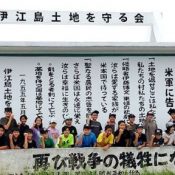
May 31, 2021 Ryukyu Shimpo
By Mitsue Chinen
On May 25, the 6th graders of Ie Elementary School learned about peace at the Danketsu Dojo (solidarity training center) in Maja, Ie Village, and in their classrooms at Ie Elementary School. The 30-hour learning opportunity raised awareness of the tragic Invasion of Ie Shima during WWII and elevated the children’s desire for peace. Director of Education Tsunenobu Uchima served as the lecturer and shared with the children the historical background of Danketsu Dojo.
Uchima explained, “Danketsu Dojo was founded in 1970 in Maja by the late Shoko Ahagon and others who fought in the Land Struggle in Ie Village under U.S. rule. The dojo served as a base for resistance against land confiscation and U.S. military exercises, and as a place to train successors in the struggle to take back land rights.” Using photos and panels, Uchima further explained, “The ‘Ie Island Land Protection Association’ advanced the fight by petitioning the U.S. government and organizing protests.”
Ryo Kurashita said, “It’s scary to think what would have happened to Ie Island if Shoko Ahagon hadn’t fought back.” Hinami Tanahara added, “If Mr. Ahagon hadn’t acted, I don’t think Ie Island would be here today, so I’m grateful.”
Makoto Hirata, a 6th-grade teacher, said, “There is a lack of knowledge of who started the war and why. [The children] study history in the 6th grade, so I hope to teach them the preciousness of peace.”
Uchima said, “Wars don’t start overnight. I want [the students to] read history books and newspapers, be curious, and learn about their world.” To conclude their learning, the students are scheduled to put on a play about peace and their local heroes.
(English translation by T&CT and Monica Shingaki)
Go to Japanese













 Webcam(Kokusai Street)
Webcam(Kokusai Street)


